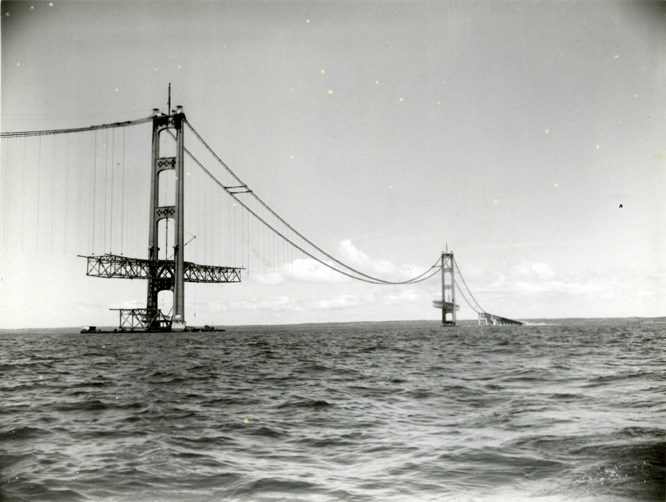From the archives of the Sault Ste. Marie Public Library:
Though the Mackinac Bridge might not be located in Canada it has still had a substantial impact on the Upper Peninsula and Sault Ste. Marie Ontario.
Its construction was one of the main driving forces behind the construction of our own International Bridge. Many Saultites have crossed the Mackinac Bridge when driving south for a day or weekend trip to perhaps Mackinac Island or even further south.
The idea of a bridge or tunnel at the Straits of Mackinac was proposed as early as 1884 when Thomas Bates of the Grand Traverse Herald wrote, “If there is to be a great through route from east to west through Michigan there must be a sure and permanent crossing at the Straits”.
While the idea of a bridge was discussed for decades there were also other suggestions including a floating tunnel or a series of bridges and causeways beginning in Cheboygan and coming up to the tip of Mackinac Island before crossing over to St. Ignace!
In 1923 a ferry service was established at the Straits but within 5 years it was so popular that a study was ordered into the merit of building a bridge across the Straits. The cost was estimated at $30 million but efforts to secure funding failed and it would not be until January of 1951 that the Bridge Authority determined that the bridge could be built and financed with revenue bonds for $86 million.
The Mackinac Bridge Authority consisted of Prentiss M. Brown (Chairman), Charles T. Fisher Jr (Vice Chairman), Mead L. Bricker, William J Cochran, George A. Osborn, Murray D. Van Wagoner, John C. Mackie and Mrs. Charles T Fisher.
However, due to the Korean War there was a shortage of materials, so legislation to build the bridge was put off until 1952. The Bridge Authority began offering its bonds for sale in March of 1953 but there were not enough takers to guarantee successful underwriting. In order to solve this issue the legislature passed an act in the spring of 1953 where operating and maintenance cost of bridge, up to $417,000 annually, would be paid for out of gasoline and license plate taxes.
With everything finally settled, construction began in 1954 on the new bridge that was designed by Dr. David B. Steinman. A huge labour force was employed in order to complete construction with 3,500 men employed at the bridge site and an additional 7,500 working at quarries, shops and mills.
The Mackinac Bridge was to be the longest single suspension bridge in the world and was one of the world’s greatest bridge engineering projects at the time. It was also the most expensive, costing approximately $99.8 million to complete. The support equipment needed during its construction was massive, requiring a huge fleet of boats including tugs, personnel, barges and whirley cranes with the ability to rotate 360 degrees.
The new bridge also boasted having the deepest and most massive foundation of any bridge in the world. The Mackinac Bridge measures 19,243 feet of steel structure but has an overall entire length of 5 miles. It stands 552 feet above the water and its piers below the water are 210 feet. The bridge also contains 42,000 miles of cable wires in the structure. The bridge was finally completed and opened to traffic on Nov. 1, 1957 but was formally dedicated June 25 to June 28, 1958.
The Mackinac Bridge allowed an increase in traffic and tourists into the Upper Peninsula, which many thought would over burden the ferry system that ran between Sault Ste. Marie Michigan and Ontario. One might say that its construction provided the much-needed kick needed to build our own bridge, which began in 1960. Though the Mackinac Bridge may no longer be the longest suspension bridge in the world, it still stands as an engineering and construction milestone.
Each week, the Sault Ste. Marie Public Library and its Archives provides SooToday readers with a glimpse of the city’s past.
Find out more of what the Public Library has to offer at www.ssmpl.ca and look for more Remember This? columns here
